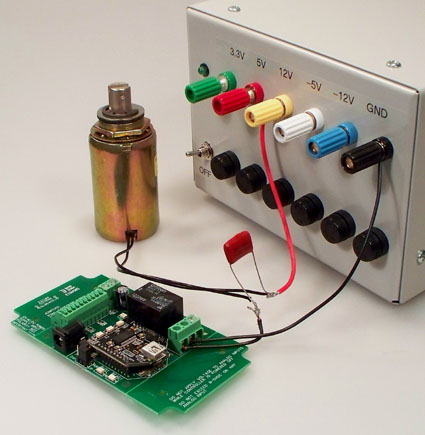|
Induction Suppression Capacitors Handling Inductive Loads |
By simply adding a capacitor to the line you will greatly reduce the electromagnetic interference that could damage the board or
interfere with the board's performance.
 Inductive loads can best be defined
as anything with a magnetic coil, such as a motor, solenoid, or a transformer. Controlling a inductive load using our relay controllers
requires the use of induction suppression capacitors. The purpose of this capacitor is to absorb the high voltages generated by
inductive loads, blocking them from the contacts of the relay. Without this capacitor, the lifespan of the relay will be greatly reduced.
Induction can be so severe that it electrically interferes with the microprocessor logic of our controllers, causing relay banks to
shut themselves down unexpectedly. In the case of USB devices, customers may experience loss of communications until the device is
reconnected to the USB port.
Inductive loads can best be defined
as anything with a magnetic coil, such as a motor, solenoid, or a transformer. Controlling a inductive load using our relay controllers
requires the use of induction suppression capacitors. The purpose of this capacitor is to absorb the high voltages generated by
inductive loads, blocking them from the contacts of the relay. Without this capacitor, the lifespan of the relay will be greatly reduced.
Induction can be so severe that it electrically interferes with the microprocessor logic of our controllers, causing relay banks to
shut themselves down unexpectedly. In the case of USB devices, customers may experience loss of communications until the device is
reconnected to the USB port.
Easy To Install
As you can see from the diagram below, a induction suppression capacitor is very easy to install. The capacitor should be located as close to the relay controller as possible, and is connected in parallel with the load you are trying to control. Induction suppression capacitors are NOT polarized, and may be used in both AC or DC applications.


Choosing the Right Capacitor
Choosing the correct induction suppression capacitor is simply a matter of choosing the maximum voltage requirement of the device you are trying to control. During checkout you will have the opportunity to purchase capacitors.Resistive Loads
Unlike inductive loads, resistive loads such a incandescent lights and element heaters (without a fan), do NOT require an induction suppression capacitor, and will NOT benefit from its use.Attention: SHARING POWERS SUPPLIES WITH INDUCTIVE LOADS
Most NCD devices are powered from a 12V power supply. NCD Devices REQUIRE a CLEAN Computer-Grade Regulated Power Supply. The power supply used to supply power to NCD Devices should not be shared with inductive loads. For instance, you should never use a single power supply to power a NCD Device and a 12V DC Motor. Doing so will introduce extremely high-voltage spikes that will damage the logic and power regulation portions of NCD devices, and in many cases, the NCD controller will NOT BE REPAIRABLE. The only known exceptions to this warning are customers who are working in automotive or other battery-powered applications where induction is naturally suppressed by integrating a large battery into the design. Filtering circuits may also be used to clean the power supply before entering the NCD controller, provided they are properly designed to work with your particular inductive load. Induction suppression capacitors may assist in the filtering of the power supply, but more study is required to determine their effectiveness at cleaning the power supply before it enters the NCD device.
Attention: HIGH VOLTAGE WARNING
Please Note: THESE CAPACITORS WILL STORE DANGEROUSLY HIGH VOLTAGES FOR SHORT PERIODS OF TIME. BEFORE HANDLING, SHORT CIRCUIT THE CAPACITOR OUTPUTS AFTER USE.